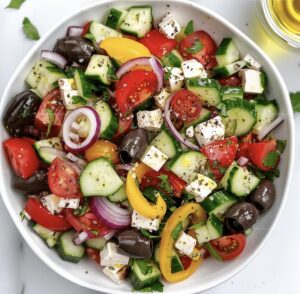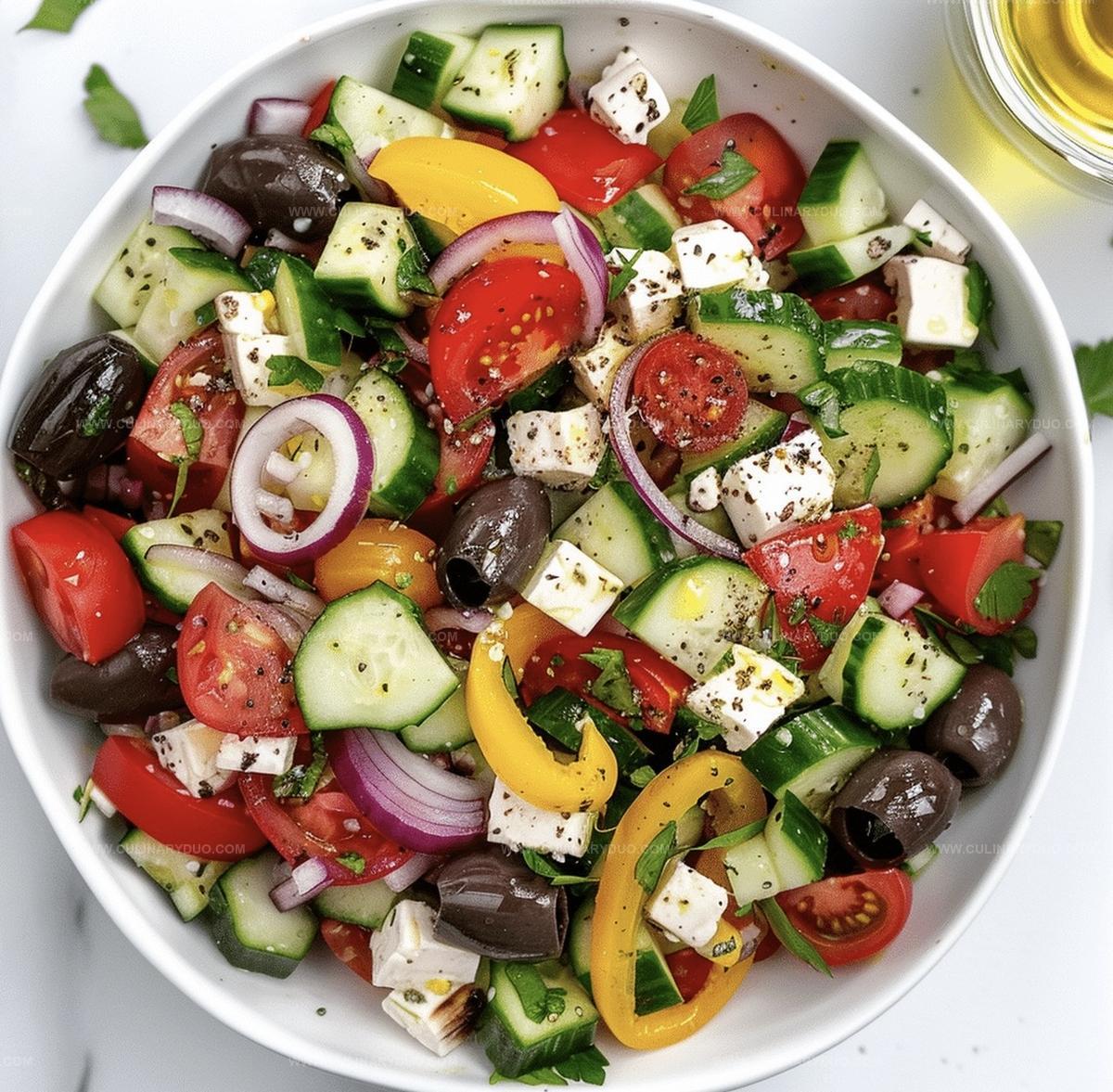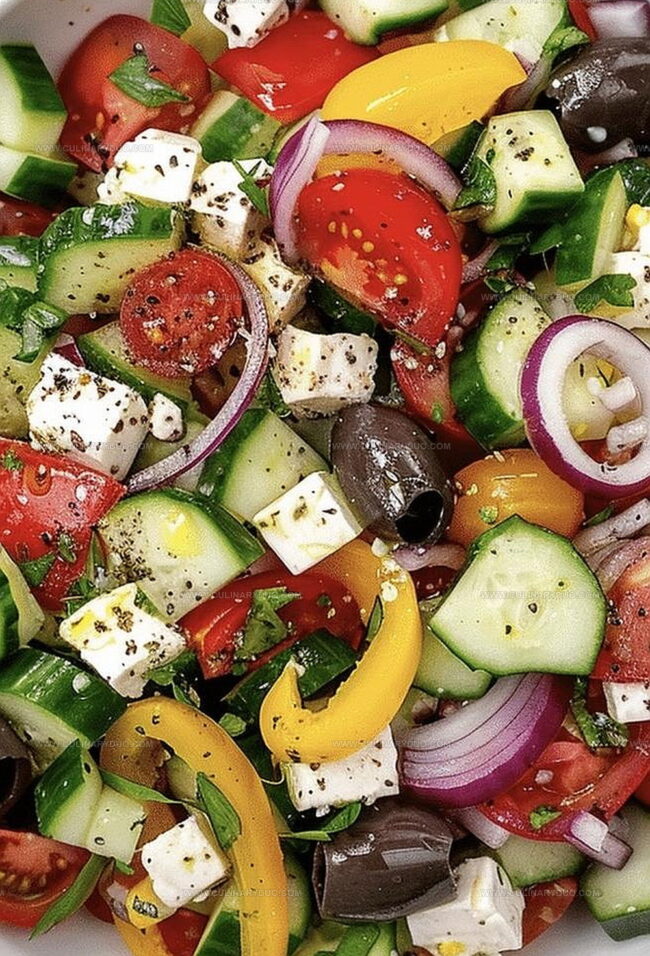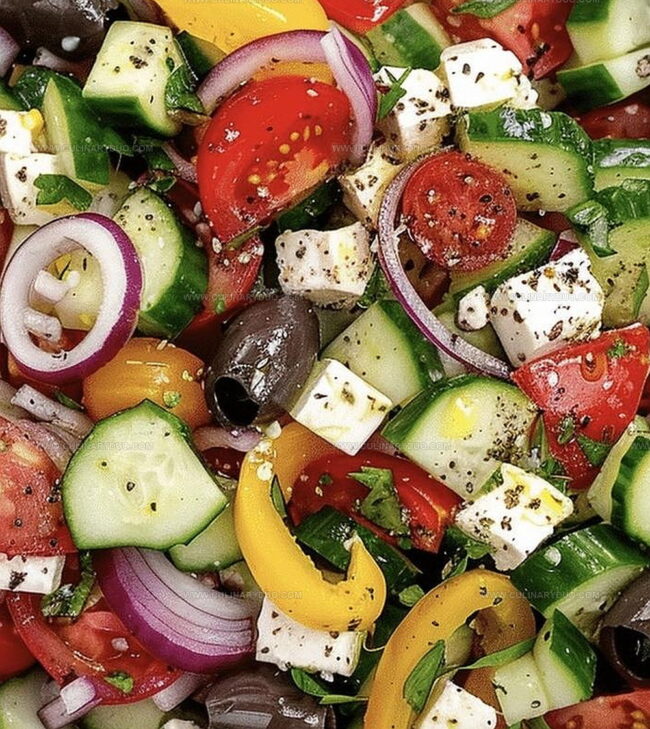Refreshing Vegan Greek Salad Recipe: A Mediterranean Gem
Crisp cucumber and zesty herbs dance together in this vibrant vegan greek salad that celebrates Mediterranean flavors.
Colorful vegetables create a stunning plate bursting with natural goodness.
Mediterranean traditions inspire every delectable bite of this plant-based masterpiece.
Fresh ingredients bring authentic Greek charm without animal products.
Tangy olives and juicy tomatoes complement the light, aromatic dressing perfectly.
Chopped herbs add an extra layer of excitement to this simple yet elegant dish.
Savor each refreshing forkful and let your taste buds explore a world of delicious possibilities.
Vegan Greek Salad For A Refreshing Bite
Ingredients For Vegan Greek Salad Goodness
Fresh Vegetables:Briny Additions:Vegan Cheese:Dressing Ingredients:Easy Steps For Vegan Greek Salad Assembly
Step 1: Prepare Crisp Veggie Base
Grab a cutting board and sharp knife.
Slice cucumber into half-moons, chop tomatoes into chunks, dice bell pepper into small pieces, and thinly slice red onion.
Aim for bite-sized, uniform pieces that will make the salad look beautiful and easy to eat.
Step 2: Combine Colorful Ingredients
Transfer all chopped vegetables into a spacious mixing bowl.
Scatter kalamata olives throughout the vegetable mixture, creating a vibrant Mediterranean-inspired palette of colors and textures.
Step 3: Create Creamy Vegan Cheese Topping
Crumble plant-based feta cheese over the vegetable blend.
Break the cheese into small, irregular pieces to ensure every bite has a tangy, creamy element.
Step 4: Whisk Zesty Dressing
In a separate small bowl, combine:Whisk ingredients vigorously until they transform into a smooth, well-integrated dressing.
Step 5: Dress and Toss Salad
Pour the freshly whisked dressing over the vegetable mixture.
Use gentle tossing motions to coat every ingredient, ensuring an even distribution of flavors.
Step 6: Serve and Savor
Present the salad immediately.
The fresh ingredients and bright dressing create a perfect summer dish that’s both nutritious and delightful.
Tips To Make Greek Salad Burst With Flavor
Vegan Greek Salad Variations For Fun
Serving Vegan Greek Salad With Style
Store Vegan Greek Salad For Later Meals
FAQs
Most grocery stores now carry vegan feta in their plant-based sections. Health food stores and online retailers also offer multiple brands like Violife and Follow Your Heart.
Yes, you can create homemade vegan feta using tofu, cashews, or almond base. Recipes typically involve marinating the base in herbs, olive oil, and lemon juice to mimic traditional feta’s tangy flavor.
The key ingredients like kalamata olives, red onions, cucumber, and the classic olive oil and herb dressing maintain the traditional Greek salad profile. The vegan feta is the only modern adaptation.
Print
Vegan Greek Salad Recipe
- Total Time: 15 minutes
- Yield: 4 1x
Description
Mediterranean Vegan Greek Salad delivers crisp cucumber, juicy tomatoes, and tangy olives in a zesty dance of plant-based flavors. Refreshing ingredients blend seamlessly, creating a light and satisfying meal you’ll crave again and again.
Ingredients
Vegetables:
- 1 English cucumber
- 300 grams (10.5 ounces) tomatoes (large or cherry)
- 1 green/red bell pepper
- 1 medium red onion
Protein and Cheese:
- 200 grams (7 ounces) block vegan feta
- 15 kalamata olives
Dressing Ingredients:
(Note: Dressing ingredients were not specified in the original content, so this section is left blank)
Instructions
- Prepare a spacious mixing vessel for assembling the vibrant Mediterranean-inspired salad.
- Slice cucumber, tomatoes, bell pepper, and red onion into uniform, appetizing chunks that ensure balanced flavor in every bite.
- Scatter chopped vegetables into the bowl, creating a colorful landscape of fresh produce.
- Sprinkle kalamata olives across the vegetable medley, introducing a rich, briny element.
- Delicately crumble vegan feta over the salad, distributing the creamy alternative cheese throughout.
- Craft the dressing by vigorously whisking ingredients in a separate container until they transform into a harmonious, emulsified mixture.
- Drizzle the zesty dressing over the salad, using gentle folding motions to ensure each ingredient is lightly coated without bruising the delicate vegetables.
- Allow the salad to rest for 2-3 minutes, permitting flavors to meld and intensify.
- Serve chilled, presenting a refreshing and vibrant plant-based interpretation of the classic Greek salad.
Notes
- Substitute traditional feta with vegan alternatives like tofu or store-bought vegan feta for authentic Greek flavor without dairy.
- Marinate tofu feta in herbs and olive oil for 30 minutes before crumbling to enhance its taste and texture.
- Ensure vegetables are crisp and fresh by chopping them just before serving to maintain maximum crunch and vibrant colors.
- Add extra protein by including chickpeas or grilled tempeh, making the salad more substantial and nutritionally balanced for a complete meal.
- Prep Time: 15 minutes
- Cook Time: 0 minutes
- Category: Lunch, Dinner, Appetizer, Snacks
- Method: Blending
- Cuisine: Greek
Nutrition
- Serving Size: 4
- Calories: 150 kcal
- Sugar: 6 g
- Sodium: 450 mg
- Fat: 12 g
- Saturated Fat: 4 g
- Unsaturated Fat: 7 g
- Trans Fat: 0 g
- Carbohydrates: 8 g
- Fiber: 3 g
- Protein: 5 g
- Cholesterol: 0 mg





Natalie Brooks
Co-Founder & Content Strategist
Expertise
Education
eCornell
Natalie brings the vibrant, plant-powered side to Culinary Duo. After earning her Plant-Based Nutrition Certificate from eCornell, she combined her love for fresh ingredients with a passion for storytelling, aiming to make healthy cooking simple and satisfying.
Her kitchen motto: good food doesn’t need a fancy label, it just needs fresh ideas and a little creativity. Outside of writing and recipe testing, Natalie’s happiest in her garden, exploring farmers’ markets, or mixing global flavors into new kitchen experiments.